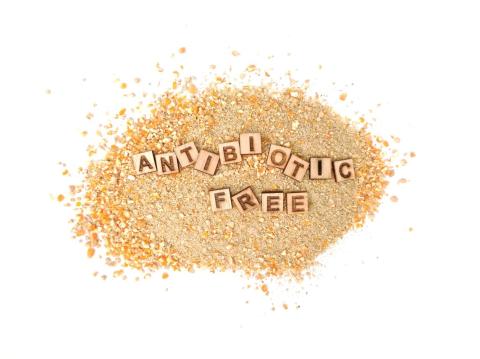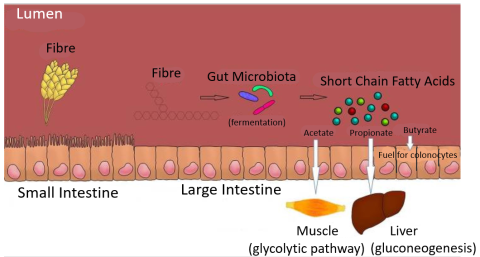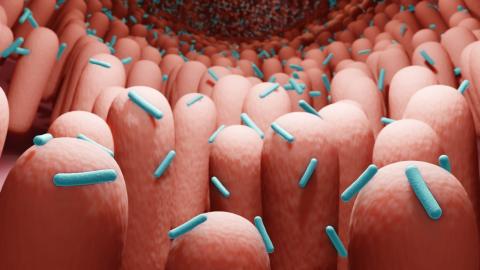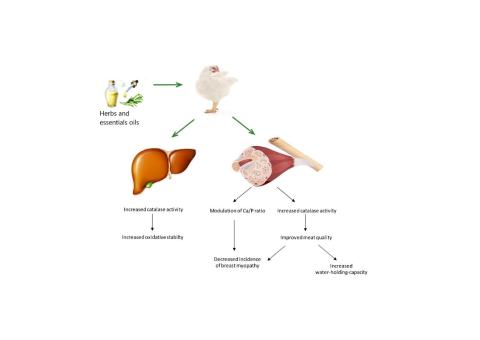7 February 2023
Saba Amir, IBERS, Aberystwyth University.
- Since the ban on the use of in-feed antibiotic growth promoters, gut health has been the focus of animal nutrition to improve performance and reduce the burden of enteric diseases
- A number of different feed additives, pre, probiotics and synbiotics, enzymes, organic acids and phytobiotics have been proven to improve gut health parameters and are commercially available but none can be considered as a “silver bullet” to managing gut health
- An holistic approach to managing gut health is necessary including biosecurity, animal welfare and good feed and water quality
- Improvement in gut health parameters by feed additives may not always translate into improvement in performance but they are proven to ameliorate the effects of pathogens or environmental stress should the animal encounter one
Introduction
Prior to 2006 antibiotics were used as in-feed growth promoters in pig and poultry diets to maintain health and efficiency. However, because of the growing threat of antibiotic resistant bacteria, an EU wide ban on the use of in feed antibiotic growth promoters (AGP) came into force in January 2006. Since then, an intensive amount of research has been focused on the development of alternatives to in feed antibiotics. The evidence to suggest that the growth promoting effect of antibiotics was via the gut microbiome existed in scientific literature since the 1960s when a group of researchers demonstrated that the antibiotics did not have any growth promoting effects in germ free chickens (chickens with a sterile gut). Thus, the quest for alternatives to in feed antibiotics paved the way to the development of knowledge on the importance of intestinal health in overall health of the animal and its production efficiency.
What is Gut Health?
Despite repeated use of the term ‘gut health’, in publications about animal health and nutrition since the 1990s, there is no specific definition to this terminology. In human health, gut health is often concomitant with absence of clinical diseases, but this cannot be applied to farm animals because animal performance can be impaired without any clinical signs of disease. A general consensus amongst animal scientists is that gut health encompasses the diet, the gut mucosa and the commensal microflora. The mucosa in turn is composed of the digestive epithelium, mucus overlying the epithelium and the Gut Associated Lymphoid Tissue (GALT). There exists a complex and dynamic equilibrium between the GALT, microbiota, mucous membrane and the host epithelium that ensures the effective functioning of the digestive system. The cross talk between all these inter-related components plays a critical role in gastrointestinal tract physiology, animal health, welfare and performance.
Several nutritional strategies have been proposed as a means to manage gut health. The effective application of feed additives to manage gut health is dependent upon some level of understanding of their mechanism of action. Growth promoting antibiotics work partly by decreasing the microbial load in the gut resulting in reduction in energy and nutrients required to maintain and nourish intestinal tissues. This means that more nutrients are partitioned towards growth and production. On the other hand, most natural feed additives do not reduce overall microbial loads. Instead, they alter the gut microflora profile by limiting the colonization of unfavourable bacteria and promote the activity and growth of more favourable species. There are several other mechanisms by which they exert their effects like altering gut pH, maintaining the protective mucous layer lining the gut epithelium, enhancing fermentation of fibre, enhancing nutrient uptake and improving immune response to pathogens.
Fibre-Degrading Enzymes
The feed ration of monogastric farm animals consists of up to 60% cereals that are rich in complex polysaccharides or non-starch polysaccharides (NSP) mainly heteroxylans and β-glucans. Pigs and poultry do produce enzymes needed to digest these molecules. Non-starch polysaccharides exert anti-nutritional effects in the gut by increasing digesta viscosity and depressing nutrient digestibility. The use of NSP-enzymes especially in diets containing barley, rye and wheat has shown to reduce viscosity and increase nutrient digestibility thereby improving performance. Secondly, NSP-enzymes make the starch and protein in the cereal grains available for digestion by host digestive enzymes by rupturing the cell wall that encapsulates them. NSP-enzymes break down large complex polysaccharides into smaller molecules that are used by the caecal microbiota to produce short chain fatty acids (SCFA). Short Chain Fatty Acids are absorbed by the epithelium and in turn have numerous beneficial effects for the host such as source of energy for intestinal epithelial cells, inhibition of pathogens, influencing regeneration of intestinal lining and development of the immune system. Because of this effect, they are able to modulate the caecal microbiota and stimulate the growth of fibre degrading bacteria which improves the nutritive value of feed. They have also been shown to significantly reduce the pathogenic bacteria and some unfavourable commensal bacteria and increase the counts of the beneficial lactic acid bacteria. Some additional beneficial effects of NSPases reported in broilers are increased digestive hormone secretion and significantly improving the performance of birds challenged with coccidiosis infection.
The use of NSP enzymes in pig and poultry diets is now almost universal in Europe and in the vast majority of commercially available diets these enzymes are added at the point of feed manufacture. A cocktail of enzyme products is also available in the market that claim to further enhance performance. The decision on the use of such products can be made following a cost vs benefit analysis with the nutritionists or the feed provider.
Fig1. Fibre fermentation and its primary utilization pathways (Jha et al., 2019). Fibre is broken down to produce short chain fatty acids that are utilized by the intestinal epithelial cells or muscles as a source of energy or by the liver for production of glycogen.
Probiotics
Probiotics, also referred to as direct fed microbials (DFMs), are being increasingly recognized as potential alternatives to antibiotics to improve production efficiency. They are defined as “live microbial feed supplements which beneficially affect the host animal by improving its intestinal microbial balance”. Another definition accepted by FAO/WHO (2001) states that “Probiotics are single or mixed cultures of live organisms which when administered in adequate amounts confer a health benefit to the host.” Probiotics, containing single or multiple strains of microorganisms, alone or in combination with other additives, are usually given in feed or water but recently novel techniques like spraying on chicks or on eggs with a developing embryo or injecting into eggs with a developing embryo (in-ovo administration) are being explored.
The first use of probiotics was reported as early as 1973 when a group of scientists inoculated 1-day-old chicks with faecal microbiota from an adult hen in order to control Salmonella contamination. Since then, several studies have been made and probiotics continue to be developed. There are several types of probiotics available in the market, with a variety of bacteria including, Bacillus, Bifidobacterium, Enterococcus, Lactobacillus, Lactococcus, Streptococcus, Pediococcus species and species of the bread yeast Saccharomyces. Probiotics may comprise of micro-organisms that are the normal residents of the gastrointestinal tract or obtained from natural sources.
Probiotics have some disadvantages compared to other modulators of gut microbiota. Some probiotic microorganisms may be reduced or eliminated by the low pH in the gizzard or stomach, and thus have little effect in the lower intestinal tract where pathogens pose problems. If a probiotic is added to the drinking water, the chlorine sanitizer may adversely affect its survivability. Acidification would be a better sanitizer than chlorine when delivering a probiotic via the drinking water. A probiotic product in the encapsulated or other protective forms, is more beneficial in delivering the probiotic organism to the hind gut.
Some reported benefits of use of probiotics in pigs include improvement in colostrum quality, milk quality and quantity, increased litter size and vitality, increase piglet weight, reduced risk of diarrhoea, improved feed efficiency, digestibility and meat quality and decreasing the severity of post weaning diarrhoea in piglets. In broilers, probiotics have shown to improve the Feed Conversion Ratio (FCR) under heat stress or pathogen challenge and reduced mortality, while in layers, probiotics improved skeletal health, increased shell thickness and reduced number of unmarketable eggs (sum of cracked and shell-less eggs).
Prebiotics
In order to be classified as a prebiotic compound, a dietary ingredient has to be:
- Neither digestible nor absorbable through the GI tract
- metabolised by one or a limited number of gut commensal bacteria
- able to induce health benefits for the host
Prebiotics essentially serve as food for the good bacteria in the gut causing them to increase in numbers. The biggest advantage of prebiotics is that they can be made from human inedible agricultural wastes like, hardwoods, corncobs, corn fibre, barley hulls, brewery spent grains, rice hulls, coconut husks and sugarcane bagasse by inexpensive heat, chemical or enzymatic treatments. They are more stable to heat and pressure incurred during feed processing and to the acidity encountered in the gizzard or stomach. Most identified prebiotics are carbohydrates and oligosaccharides with different molecular structures. Dietary fibres are candidate prebiotics, but most promising are nondigestible oligosaccharides (NDOs) such as fructo-oligosaccahride (FOS), galacto-oligosaccahride (GOS), mano-oligosaccharide (MOS) and xylo-oligosaccharide (XOS). Mannan oligosaccharides (MOS) are categorised as prebiotics but they do not selectively enrich for beneficial bacterial populations, nor are they obtained from plants like other prebiotics. They are obtained from the cell wall of the bread yeast Saccharomyces cerevisiae and are able to bind and physically remove pathogens such as Salmonella and E.coli from the intestine. Prebiotics are directly fermented into SCFAs by commensal bacteria or stimulate these bacteria to produce more of their fibre degrading enzymes which helps to digest the fibre fraction of feed into SCFAs (the beneficial effects of SCFA have been described in the above sections).
Prebiotics are added to swine diets in the range of 5 – 40 g/kg while in poultry diets the dosage varies from 1 – 20 g/kg of feed. The results from research trials using prebiotics in pigs and poultry are somewhat inconsistent where some studies have reported no significant improvements in weight gain or feed efficiency of animals fed prebiotics compared to the control. But these differences in results may be due to differences in the composition of the basal diet, dosage, feeding duration and more importantly the fact that the animals may already be growing to their maximum production potential under controlled research conditions. However, the vast majority of the studies agree that prebiotics ameliorate the effects of environmental stress such as heat or high stocking density or stress due to pathogens in both pigs and poultry. Research has also shown that incorporating prebiotics in post hatch or post weaning diets is particularly valuable for the animals as it helps in the early colonization of the intestine with beneficial bacteria which in turn reduces mortality and helps in the development of the immune system. Finally, prebiotics can be considered as an inexpensive insurance against dysbacteriosis (imbalance in the gut microbiota) especially on low efficiency farms which require major financial investments in infrastructure to function optimally.
Fig: Intestinal epithelium colonised by commensal bacteria
Synbiotics
Synbiotics may be defined as a mixture of pre and probiotics in an encapsulated form that beneficially affects the host by improving the survival and implantation of the probiotic in the gastrointestinal tract. Fundamentally they exert the same effects as pre and probiotics. Results from animal trials do show a synergistic effect of coupling pre and probiotics, for example, better weight gain and feed efficiency and enhanced clearance of pathogens compared to use of pre and probiotics alone.
Organic Acids
Dietary organic acids have been considered as potential alternatives to AGPs, owing to their antibacterial nature. Some examples of the ones used in animal feed are formic, acetic, propionic, butyric acids, lactic, malic, tartaric, and citric acids. They can be given in feed or drinking water. Commercially they are available as single acids or their salts (sodium, potassium, or calcium salts) or as combinations of multiple acids or their salts. These acids either kill or stop the growth of pathogenic bacteria but the beneficial lactic acid bacteria and Bifidobacterium are unaffected as they are acid tolerant.
One organic acid that is worthy of a special mention is butyric acid. As mentioned above it is one of the acids produced as a result of fermentation of fibre or NDOs in the caeca but it is also used as a feed additive in the form of its Na salt (Na-butyrate). In a large number of studies butyrate has demonstrated positive effects on gut development, gut integrity and development of immunity, improved weight gain and carcass quality. In other studies, it has reduced the burden of Salmonella and Clostridium perfringens (causative agent of necrotic enteritis). The use of protected encapsulated forms of butyrate is recommended over the unprotected form, as the unprotected form is absorbed in the proximal parts of the intestine and therefore has no effect on pathogen colonization in the ileum or caeca. The protected form can combat the potential decrease in concentrations and control its subsequent release as it passes through the gastrointestinal tract. Weaned piglets undergo a period of growth lag caused by early weaning. At this stage their gastro-intestinal tract is underdeveloped and hence they are unable to properly digest solid feed. Butyrate, due to its positive effect of cell proliferation and gut development, has been shown to improve nutrient digestibility in piglets leading to improved growth performance. Inclusion of butyrate in diets has also been shown to improve the sensory quality of pig meat by reducing its boar taint.
The theme of butyrate being an alternative to antibiotics is evidently very strong. This is especially apparent in the studies that used a butyrate derivative as a direct replacement for an antibiotic, but also observed in studies where butyrate-fed animals are challenged with a pathogen.
Phytobiotics
Phytobiotics or phytogenic feed additives (PFAs) are naturally occurring bioactive compounds derived from plants that are known to benefit growth performance. Depending on how the active ingredients are derived, PFA may also be described as essential oils (EOs; volatile lipophilic substances obtained by cold extraction or by steam or alcohol distillation) and oleoresins (extracts derived by non-aqueous solvents). Solid, dried and ground forms of herbs and spices are also phytobiotics. In the majority of PFAs the key active components are polyphenols (naturally occurring compounds in fruits, vegetables, herbs and spices). A wide variety of herbs and spices including: thyme, oregano, rosemary, marjoram, garlic, ginger, green tea, black cumin, coriander and cinnamon, in either the form of powders or essential oils, have been tried for their potential applications as alternatives to infeed antibiotics in pigs and poultry. In contrast to pre and probiotics which exert their effect via SCFAs, polyphenols (active component of phytobiotics) can be absorbed in the blood and have a direct effect on gut health.
Phytobiotics have positive effects in improving the performance of poultry and pigs probably due to improved palatability of feed leading to increased feed intake and better weight gain. They improve nutrient digestibility by increased pancreatic enzyme production and activity and increase bile secretion. Phytobiotics are potent antioxidants. Because of their antioxidant properties they have been shown to improve the quality of pork, chicken and duck meat. Like SCFA they also have antibacterial properties. They have been shown to reduce the counts of pathogens, E.coli and Clostridium perfringens (the causative agent of necrotic enteritis) and reduced the lesions caused by Eimeria (the causative agent of coccidiosis) in research studies in broilers.
Fig 2: How phytobiotics improve meat quality (adapted with modifications from Estevez and Petracci, 2019)
Summary
Owing to the ban on infeed antibiotics and rise in demand for livestock products from antibiotic free production systems there exists a need for antibiotic alternatives that can improve performance and maintain optimal health of food animals. Several products have been evaluated in pigs and poultry over the past decade for their potential to replace antibiotics. Though the beneficial effects of these alternatives have been well demonstrated results can vary from farm to farm. Combinations of products may prove more beneficial than using them alone to achieve an effect similar to that of antibiotics. Most importantly an holistic approach to managing gut health and improving performance is necessary which includes good animal welfare practices and stringent biosecurity measures on farm.
If you would like a PDF version of the article, please contact
heledd.george@menterabusnes.co.uk




